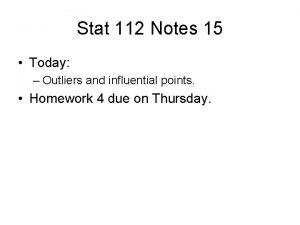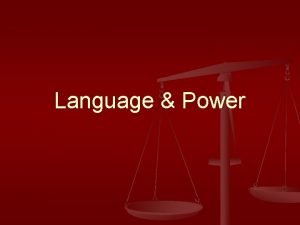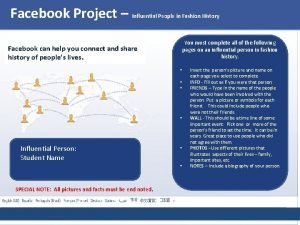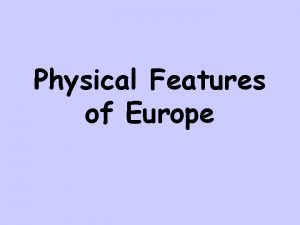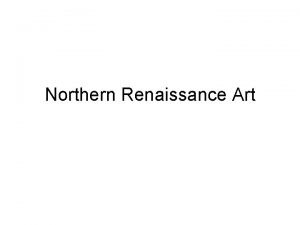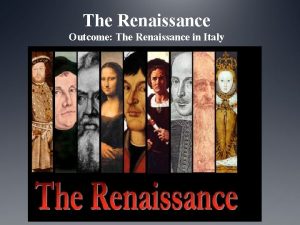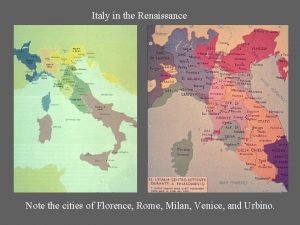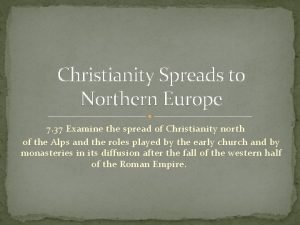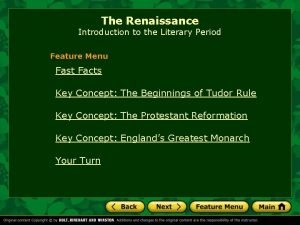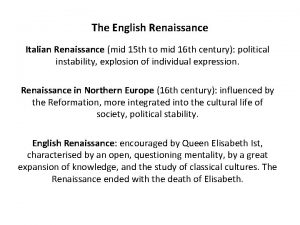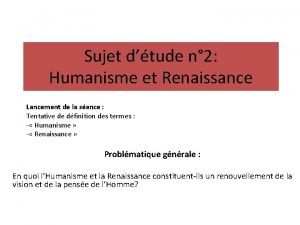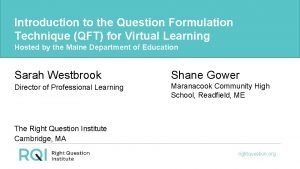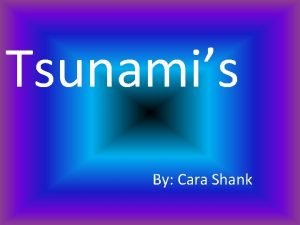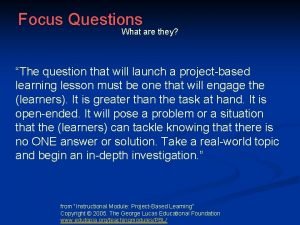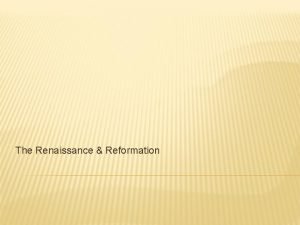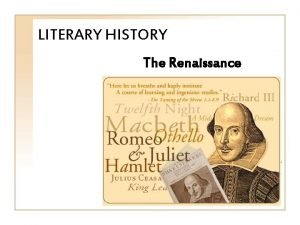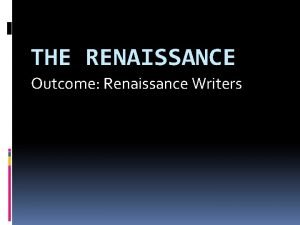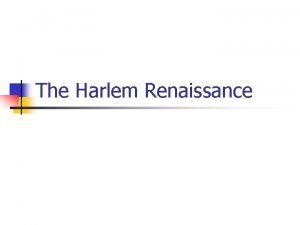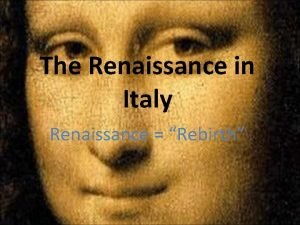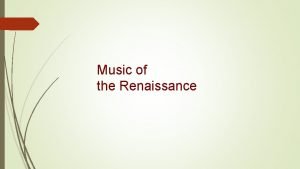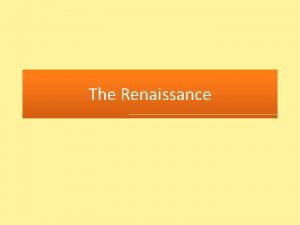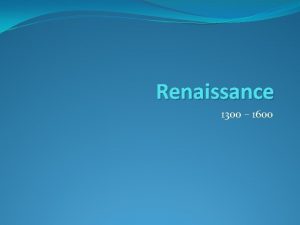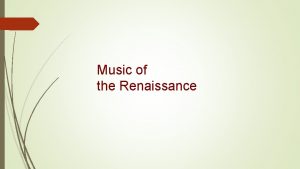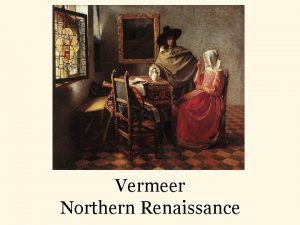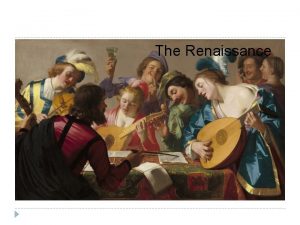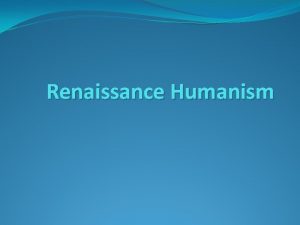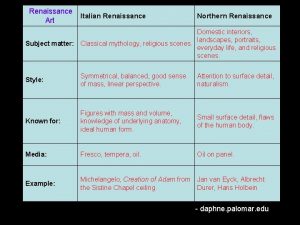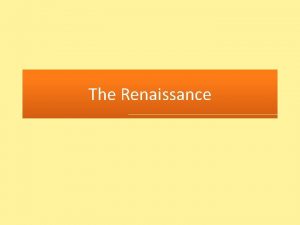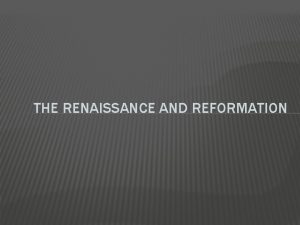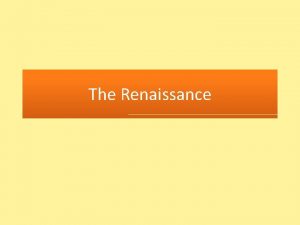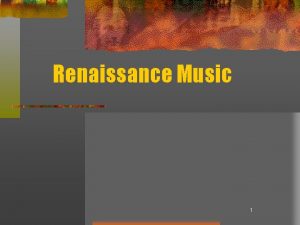The Renaissance Focus Question Focus Question How influential
























- Slides: 24

The Renaissance

Focus Question • Focus Question: How influential were internal factors (e. g. Renaissance, Reformation, demographic, economic, and social changes) and factors external to Europe in increasing Europe’s global power?

The Middle Ages (Medieval Period) • 5 th century – 15 th century AD • Fall of Rome Renaissance • Europe mostly peasant farmers • Little education & low literacy • Christianity + superstition

The Renaissance • 1350 -1550 AD • Began in Italy • Moved northward • Eventually covered Europe • Took place in cities / didn’t affect most Europeans at first • Christianity w/o superstition

Characteristics of the Italian Renaissance • 1. Urban Society (cities) • 2. Secular Society (Society not run by religion) • 3. Humanistic (people should learn & make society better)

1. Urban Society • Italy was not a unified country • Independent, powerful cities ruled areas surrounding them • City-states = rivals, not allies • Most powerful: Venice, Milan, Florence, and the Papal States

The most powerful citystates were those with ports (Venice) or on key trade routes (Milan, Florence).

Milan • South of key Alps mountain passes • Trade between Italy/Middle East & rest of Europe came through • Controlled trade & charged tariffs

Venice • Most important port city in Italy • Geographic tie between Europe, Asia, Middle East • Dependence on sea trade led to strong navy, too

Venice • Called a republic • Doge = elected leader (his palace & prison at left) • In reality, a few wealthy bankers and merchants ran Venice

Florence • Owned Tuscany • Small group of rich merchants ran government • The de’ Medici family made it the cultural center of Italy & Europe

2. Secular Society • Focus on worldly things • Recurrences of the Plague and ongoing wars shortened lives • Increased wealth + short lives = “eat, drink & be merry” • Not atheistic or anti-Christian

3. Humanistic • Medieval beliefs on life: – mankind is evil – the world is sinful – one’s focuses in life should be avoiding sin & getting to heaven

• Renaissance beliefs on life: – man is made in God’s image and is imperfect, but not evil – the world was created by God and is corrupt, but improvable – one’s focus in life should be on gaining personal knowledge to become a better citizen

The point of Renaissance education is not to create great scholars, but to create great citizens!

A few, good Renaissance Men:

Machiavelli • Wrote “The Prince” • Believed that rulers’ only duty was to build strong city-states • Rulers can & should ignore morality & their consciences • Ends justify means

Leonardo da Vinci • The ultimate “Renaissance Man” • Handsome & popular • Avid mountain climber • Excelled in all areas of the “liberal arts” / art, mathematics, literature, science, invention, etc.

“Renaissance Men” (and women) don’t just try many things. They are great at many things!

What happened to Renaissance Italy?

Wars of Italy • The city-states of Italy had great financial and artistic wealth • Other countries wanted to take it • City-states might be as wealthy as kingdoms, but had fewer people • They had to use their wealth to hire foreign armies to defend them

Wars of Italy • 1494 – France attacks Naples, a large but weak, southern city-state • Nervous that they might be next, but too small for self-defense, the other city-states hired Spain • For 30 years, the Wars of Italy destroyed its once-great cities

Wars of Italy • Thus, the Wars of Italy were fought in Italy, but didn’t really involve any Italian armies • Eventually Spain defeated France • The Spanish army hadn’t been paid, and in 1527, attacked and destroyed Rome for plunder

The Renaissance • The Wars of Italy destroyed Italy • Most of the accomplishments of the Renaissance in Italy were lost • However, by this time, the values and learning of the Renaissance had spread to the rest of Europe, and its legacy was preserved there
 Outliers and influential points
Outliers and influential points Instrumental power examples
Instrumental power examples Louis benech louboutin
Louis benech louboutin Physical characteristics of europe
Physical characteristics of europe Costa level question
Costa level question Northern vs italian renaissance
Northern vs italian renaissance The renaissance outcome the renaissance in italy
The renaissance outcome the renaissance in italy Outcome of renaissance
Outcome of renaissance Last supper labeled
Last supper labeled Italian renaissance vs northern renaissance venn diagram
Italian renaissance vs northern renaissance venn diagram The renaissance introduction to the renaissance answer key
The renaissance introduction to the renaissance answer key The renaissance outcome renaissance painters/sculptors
The renaissance outcome renaissance painters/sculptors Italian renaissance vs english renaissance
Italian renaissance vs english renaissance Actor focus vs object focus
Actor focus vs object focus Focus on form vs focus on forms
Focus on form vs focus on forms Cost leadership strategy
Cost leadership strategy Porter's generic strategies
Porter's generic strategies Question problématisée renaissance humanisme
Question problématisée renaissance humanisme Qft questioning
Qft questioning Tsunami questions
Tsunami questions What is a focus question
What is a focus question Bổ thể
Bổ thể Tư thế ngồi viết
Tư thế ngồi viết Thẻ vin
Thẻ vin Ví dụ giọng cùng tên
Ví dụ giọng cùng tên
